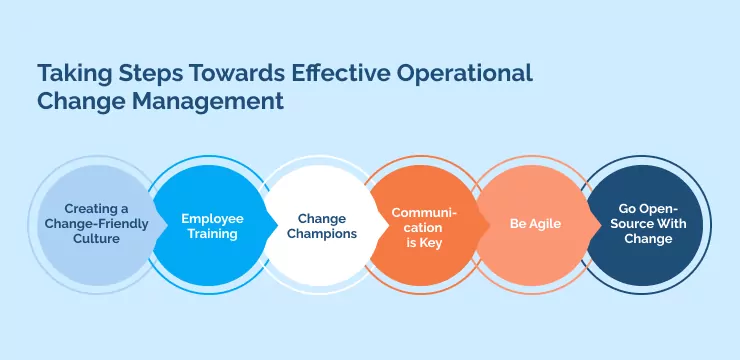
Usually, businesses approach change management slowly. They think it through and plan every step. More often than not, the slowness of a company’s ability to change is a problem.
But that’s not always the case.
Some types of changes may businesses make too quickly, like changes to internal communication and administrative procedures.
Even seemingly minor changes need to be managed properly if you want results, and these back-end changes often get neglected. They’re barely planned, launched with haste, and employees are left in the lurch trying to figure out how to deal with the change.
Organizational development and human resources professionals understand the importance of changing the organization’s operations.
They know that this type of change management is critical to running a successful business. It’s not just about introducing new products or services or restructuring departments – it’s also about how well you implement operational changes.
This article will address this problem by exploring and explaining operational change management.
- What is it?
- How do operational changes differ from other types of change?
- Why should you care?
- What can you do to promote better operational change management in your organization?
If you’re part of a project team, you need to be able to answer these questions. By the time you’re done reading, you’ll understand all there is to know about operational change management and be able to communicate changes better across your organization.
What Is Operational Change Management?
Changes can be separated into four major categories:
- Mission changes
- Strategic changes
- Operational changes
- Technological changes
Mission changes involve tweaks to how you’re delivering value to customers or clients, while strategic changes address long-term goals or strategies. Technological change is related to introducing new tools or technologies into the organization.
But today, we’re talking about operational changes.
These operational changes differ from other types of organizational change management processes in that they are focused on the day-to-day operations of a business.
We’re talking about changes to internal operational processes, such as administrative procedures, supply chains, and operational policies.
Operational change management can include anything from minor rule tweaks or modifications to major overhauls of operational systems.
Why Should You Care About Operational Change Management?
You already know why change management, in general, is important:
47% of organizations that integrate change management are more likely to meet their objectives than the other 30% that did not incorporate it.
But why should you care about operational change management in particular?
It’s easy to think operational change management isn’t that important, especially when compared to other types of change management. But operational changes can greatly impact how your business functions, and it pays to get them right.
Operational change management is often the least understood and least discussed type of change process. But operational changes can play a big role in the success or failure of your organization.
A poorly implemented operational change management program can lead to everything from disgruntled employees who don’t know how to use new systems to operational failures that put your business at risk.
That’s why operational change management is so important.
It’s about ensuring operational changes are implemented to minimize disruption and confusion while also ensuring operational goals are met.
It should be one of the core components of your change management strategy. Without operational change management, operational changes can quickly become chaotic, leading to frustration and confusion within your organization.
The bottom line is you cannot neglect operational change management just because the issues won’t be customer-facing.
Why Do Operational Changes Fail?
Did you know that only 34% of change initiatives succeed?
What exactly is going wrong to output such a dire statistic? Honestly, it’s not rocket science— business leaders miss the problems because they seldom see the operational change process.
Here are a few of the common problems that cause 66% of change initiatives to fail:
Poor Strategy
Businesses often make the mistake of not spending enough time on planning operational changes. This leads to a change process that is poorly thought out and not properly aligned with your company’s overall goals or objectives.
On the other end, some businesses plan their changes too rigidly.
You’ll no doubt learn some lessons along the way, and you should be prepared to incorporate those lessons into the change process on the fly.
Unrealistic Expectations
Businesses often also set unrealistic expectations during the operational change process.
This can lead to too complex changes or require too many resources, leading to failure. More commonly, though, businesses assume they can do more than they can within a set deadline.
Always be prepared for something to go wrong during the change management process, and know how you’ll adjust.
Employees Resist Change
Employees are often resistant to operational changes, particularly if they don’t understand the purpose or goals of the change process.
This leads to changes being met with confusion and frustration. Employees are less likely to adopt new processes and changes to their established working methods without very good reason.
Lack of Leadership Support
It’s not just employees that resist change. It’s business leaders, too.
You need leadership buy-in before kicking off a change process.
Get the support of the leaders at the top of the business units the change will affect. Without leadership buy-in, back-end processes will not change.
The pressure for employees to adapt must come down from the top.
Communication With Key Stakeholders is Unclear
If you fail to communicate the overall strategy behind the change process, you’re less likely to see support from leaders and team members.
If you fail to communicate the intricacies of a change, nobody will know what they’re supposed to be doing after you implement change.
Good communication at every stage is essential to successful implementation.
Strategy Doesn’t Match Culture
Some businesses will adjust their strategy without ever considering the company culture. If you have a culture that resists changes, you won’t get very far with a new strategy focused on rapid transformation.
It isn’t enough to tell employees how they should feel. You need to create a change-friendly culture to match your strategy.
Ultimately, you can’t avoid change initiatives failing sometimes. With that in mind, it’s important to have a rollback plan to minimize disruption to your business when it happens.
Taking Steps Towards Effective Operational Change Management
If any of those problems strike a chord, don’t fret. Creating the foundation for an effective operational change management program isn’t easy, per se, but it is simple.
Here are a few things you can do to bring your business closer to consistent and effective operational change management:
Creating a Change-Friendly Culture
If you make operational changes, it’s important to create a culture that supports change. This means building trust with your employees.
This will give people confidence in the process and make them more likely to embrace operational changes.
Creating a change-positive culture is one of the most effective things you can do, so here are a couple of practical changes you can make:
Employee Training
Invest in employee training. Ensure the teams affected by operational changes know exactly what they’re doing with new business processes.
The onus is on you to make them feel empowered by changes, not ostracized by them.
Change Champions
Strategically placed “change champions” can fertilize your company culture to allow change to blossom.
These team members take on additional responsibilities to act as the bridge between the change management team and the rest of the team. They might aid in employee training or be the first line of support post-go-live.
Communication is Key
Communication of operational changes must be open and clear. Everyone affected should know what’s happening, when, and why.
Communication about operational change initiatives needs to come from the top down. Leaders need to be informed and involved for operational changes to occur successfully.
Clear communication of goals, objectives, and requirements should also be given to all affected employees so that everyone understands what’s expected of them in the new operational structure.
Be Agile
Agility is key when it comes to operational changes. Adjusting quickly to changing business needs and employee concerns is essential for success.
Make sure you plan accordingly and set realistic expectations. Don’t try to do too much in a short time or make the business process overly complex—this will lead to confusion and frustration.
Give yourself some wiggle room— and use it.
Go Open-Source With Change
Everything we’ve said is simple, but this is a deeper dive into the world of change management.
Gartner’s organizational change guidance outlines an “open-source change” strategy that aligns closely with Agile principles. It encourages early transparency and employee-led change, allowing an organization to make faster decisions and adapt quickly.
Taking an open-source approach to change management addresses all of the common issues and paves the way to a more Agile business overall.
Looking Inward: Nurturing Your Operational Change Management Process
Too often in business, we get caught up looking outward at what our customers are demanding and what our competitors are doing.
We don’t see operational change management as an important process because it only affects the running of the internal business.
It’s time to look inward and take care of those internal processes. They are the bedrock upon which your business stands.
WalkMe Team
WalkMe spearheaded the Digital Adoption Platform (DAP) for associations to use the maximum capacity of their advanced resources. Utilizing man-made consciousness, AI, and context-oriented direction, WalkMe adds a powerful UI layer to raise the computerized proficiency, everything being equal.






